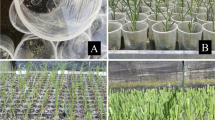Abstract
In vitro culture of barley calluses has been used to produce plants with increased glyphosate tolerance. Calluses from immature embryos of barleyHordeum vulgare L. (‘Jeff’) were cultured on Murashige and Skoog medium with 10-6, 10-5, 10-4, 5×10-4, 10-3, or 10-2M glyphosate for one, four or thirty months. Plants were regenerated from calluses maintained in glyphosate medium at 10-6, 10-5 or 10-4M for four months, at 10-5 or 5×10-4M for one month and at 10-5M for thirty months. The progeny of each regenerated plant was analyzed for response to glyphosate. Some progenies showed increased tolerance to glyphosate.
Similar content being viewed by others
Abbreviations
- AN:
-
Amaji Nijo
- 2,4-d :
-
2,4-dichlorophenoxyacetic acid
- EPSP synthase:
-
(5-enolpyruvylshikimate-3-phosphate synthase)
- glyphosate:
-
(N-phosphonomethyl glycine)
References
AmrheinN, JohanningD, SchabJ & SchulzA (1983) Biochemical basis for glyphosate-tolerance in a bacterium and a plant tissue culture. FEBS Lett 157: 191–196
AvivD & GalumE (1977) Isolation of tobacco protoplasts in the presence of isopropyl-N-phenylcarbamate and their culture and regeneration into plants. Z. Pflanzenphysiol. 83: 267–273
BaillieAMR, RossnagelBG & KarthaKK (1993)In vitro selection for improved chlorsulfuron tolerance in barley (Hordeum vulgare L). Euphytica. 67: 151–154
BairdDD, UpshurchRP, HomeselyWB & FranzJE (1971) Introduction of a new broad spectrum post-emergence herbicide class with utility for herbaceous perennial weed control. Proc. North Cent. Weed Control Conf. 26: 64–68
Bozorgipour R & Snape JW (1991)In vitro selection of herbicide tolerant variants of wheat. In: Caseley JC, Cussans GW & Atkin RK (Eds.) Herbicide Resistance in Weeds and Crops, XI Long Ashton Int. Symp. Sep. 1989. Butterworth. (pp 422–423)
ChoHI, WidholmJM & SlifeFW (1986) Effects of haloxyfop on corn (Zea mays) and soybean (Glycine max) cell suspension cultures. Weed Sci. 34: 496–501
CreasonGL & ChaleffRS (1988) A second mutation enhances resistance of a tobacco mutant to sulfonylurea herbicides. Theor. Appl. Genet. 76: 177–182
DoreC, CauderonY & ChuecaMC (1988) Inflorescence culture ofTriticum aestivum xSecale cereale hybrids: production, characterization and cytogenetic analysis of regenerated plants. Genome 30: 511–518
DuncanDB (1955) Multiple range and multiple F test. Biometric 11: 1–42
DyerWE, WellerSC, BressanRA & HerrmannKM (1988) Glyphosate tolerance in tobacco (Nicotiana tabacum L.). Plant Physiol. 88: 661–666
FolmarLC, SandersHO & JulinAM (1979) Toxicity of herbicide glyphosate and several of its formulations to fish and aquatic invertebrates. Arch. Environ. Contam. Toxicol. 8: 269–278.
Gronwald JW, Parker WB, Somers DA, Wyse DL & Gengenbach BG (1989) Selection for tolerance to graminicide herbicides in maize tissue culture. Brighton Crop Prot. Conf. Weeds 1217–1224
JordanMC & McHughenA (1987) Selection for chlorsulfuron resistance in flax (Linum usitatissimum) cell cultures. J. Plant Physiol. 131: 333–338
KarpA & MaddockSE (1984) Chromosome variation in wheat plants regenerated from cultured immature embryos. Theor. Appl. Genet. 67: 249–255
Kenyon PD, Marshall G & Morrison IN (1987) Selection for sulfonylurea herbicide tolerance in oilseed rape (Brassica napus) using mirospore culture. British Crop Prot. Conf. Weeds 871–877
LapitanNLV, SearsRG & GillBS (1984) Translocations and other karyotypic structural changes in wheat x rye hybrids regenerated from tissue culture. Theor. Appl. Genet. 68: 547–554
LarkinPJ & ScowcroftWR (1981) Somaclonal variation — a novel source of variability from cell culture for plant improvement. Theor. Appl. Genet. 60: 197–214
LarkinPJ, RyanSA, BrettellRIS & ScowcroftWR (1984) Heritable somaclonal variation in wheat. Theor. Appl. Genet. 67: 443–455
LeeTT (1980) Characteristics of glyphosate inhibition of growth in soybean and tobacco callus cultures. Weed Res. 20: 365–369
MurashigeT & SkoogF (1962) A revised medium for rapid growth and bioassays with tobacco tissue cultures. Physiol. Plant 15: 473–497
NafzigerE, WidholmJM, SteinruckenHC & KilimerJL (1984) Selection and characterization of a carrot cell line tolerant to glyphosate. Plant Physiol. 76: 571–574
PintoJEBP, DyerWE, WellerSC & HerrmanKM (1988) Glyphosate induces 3-deoxy-D-arabino-heptulosonate 7-phosphate synthase in potato (Solanum tuberosum L.) cells grown in suspension culture. Plant Physiol. 87: 891–893
RoggenPMvan, KirkwoodRC & BoydPA (1992) Developing herbicide tolerance in peas:in vitro selection. Pestic. Sci. 34: 96
SaltoT, CostaJ & Garcia BaudinJM (1989) Eficacia a corto plazo de una nueva formulacion de glifosato. Proc. 4 EWRS Mediterranean Symposium. I: 174–178
SaxenaPK, WilliamsD & KingJ (1990) The selection of chlorsulfuron-resistant cell lines of independent origin from an embryogenic cell suspension culture ofBrassica napus L. Plant Science 69: 231–237
ShanerD, MalefytT & AndersonP (1985) Herbicide resistant maize through cell culture selection. In: Biotechnology and its Application to Agriculture. Monograph n 32, BCPG Publications, Thornton Heath UK (pp 45–50)
SingerSR & McDanielCN (1985) Selection of glyphosate-tolerant tobacco calli and the expression of this tolerance in regenerated plants. Plant Physiol. 78: 411–416
Sokal RR & Rohlf FJ (1981) Biometry. WH Freeman and Company Ed. (859 p.)
Taleb G (1983) Analyse cytogénétique de plantes androgénétiques doublés spontanément chezTriticum aestivum L. Thèse 3ème cycle. Université Paris-Sud, Centre d'Orsay
WersuhnG, KirschK & GienappR (1987) Herbicide tolerant regenerants of potato. Theor. Appl. Genet. 74: 480–482
Author information
Authors and Affiliations
Rights and permissions
About this article
Cite this article
Escorial, M.C., Sixto, H., García-Baudin, JM. et al. In vitro culture selection increases glyphosate tolerance in barley. Plant Cell Tiss Organ Cult 46, 179–186 (1996). https://doi.org/10.1007/BF02307093
Received:
Accepted:
Issue Date:
DOI: https://doi.org/10.1007/BF02307093




